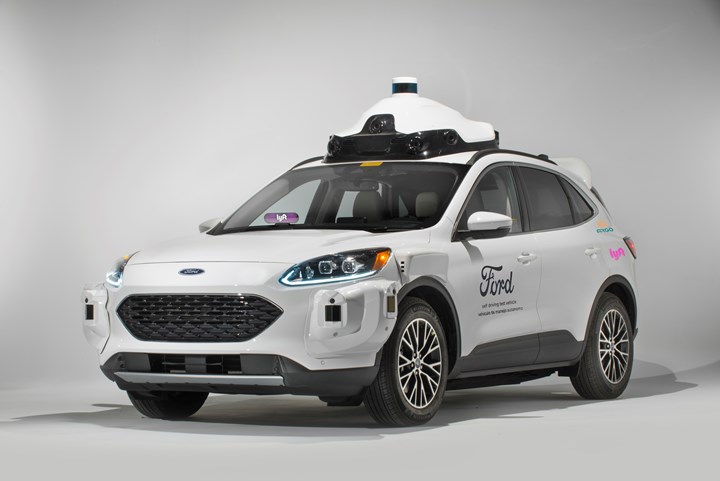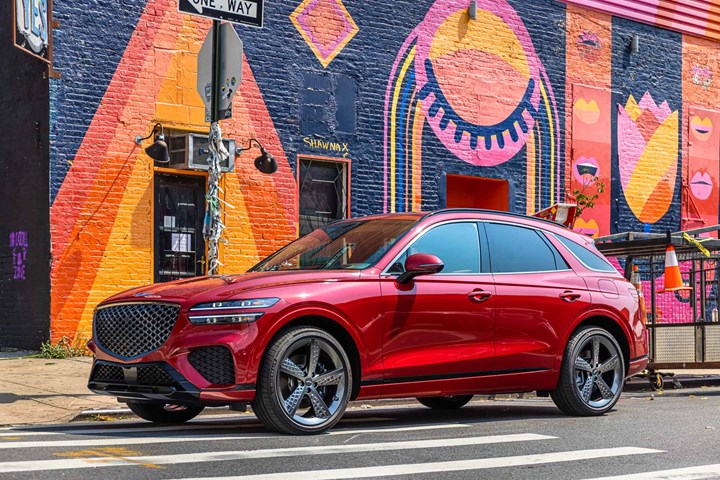On EV Sedans, Self-Driving Tech, 15-minute Cities and more
Will EVs save the sedan? Will anyone in the UK tell grandpa to give up the keys? What to do with broken windshields. And much more.
This week On Automotive
- The Probable Future of Sedans (Yes, They Have One)
- Great Explanation of the Advantage of Self-Driving Tech
- Grandad Keeping the Keys in the UK
- From Here to There—In 15 Minutes
- Notes to Consider About the Genesis GV70
- Beyond the Broken Windshield
///
The Probable Future of Sedans (Yes, They Have One)

The refreshed ‘22 Jettas (GLI version in the rear). VW thinks that sedans have a future. (Image: Volkswagen)
Volkswagen of America (VoA), in preparing to launch the refreshed Jetta and Jetta GLI compact sedans, looked at its sales numbers for sedans—the Jetta, Passat and Arteon accounted for about 29% of sales.
VoA is making big efforts in building out its portfolio of crossovers (Atlas, Atlas Cross Sport, ID.4, Taos and Tiguan).
But going forward, what does Hein Schafer, VoA senior vice president, Product Marketing and Strategy, think about what is going to happen to sedan sales?
He thinks it may soften some—but given the right amount of space, the size of the vehicle and, most importantly, the value proposition offered, it should hold its own.
But here’s something that could be encouraging to those who don’t want to see the disappearance of sedans:
Schafer points out that as there is a growth in electric vehicles, the aerodynamic characteristics of sedans are superior—think of the drag.
“Battery electric vehicles may result in the revival of sedans,” Schafer says, pointing out that Tesla certainly showed that sedans have consumer appeal with its Model 3.
So it isn’t the body style that’s the problem. It’s what that body look likes—and evidently what powers it.
///
Great Explanation of the Advantage of Self-Driving Tech

Argo AI Ford Escape development vehicle. (Image: Ford)
“People ask me all the time, ‘Well, how is it any different than how a human thinks about things?’ Well, the difference is a human’s sort of picking the top two or three things that are relevant at the time. And if they make a mistake in that judgment, and they pick the wrong thing to focus on, or if they’re distracted, typically that’s when collisions happen, right?
“The advantage with self-driving tech is that our software stack can reason about literally thousands of objects at the same time, and be tracking each individual bike, pedestrian, and car that’s in a busy surface street, and be able to extrapolate not just what are they doing now, but what are they going to be doing several seconds in the future. It doesn’t get tired, it doesn’t get distracted, it’s always learning and improving. And this is where the safety proposition comes from.”
Bryan Salesky, CEO, Argo AI on the “Decoder with Nilay Patel” podcast, August 17, 2021
///
Grandad Keeping the Keys in the UK
82
That’s the average age that people over 60 in the UK say is when they’ll stop driving.
This according to a survey conducted by IAM RoadSmart, a UK-based road safety charity.
Here are some rather interesting numbers:
- Drivers under 70 (but at least 60) said the average age they’d stop driving was 79.4 years
- Drivers 70 and up put the age at 85.3
Looks like the closer one gets the further one wants to put it off.
This should put some of those answers into perspective:
- 79% rated their driving ability as “good to excellent”
Of course.
But they do have support from Neil Greig, Policy & Research Director from IAM RoadSmart, who observed, “There are over 12.1 million drivers of 60+ according to the report. With many being healthy, fit and with over 40 years’ experience and knowledge, why shouldn’t they continue to drive?”
We’ll let you come up with your own answers.
///
From Here to There—In 15 Minutes

Google will help you scoot with Spin. (Image: Ford)
While on the subject of numbers. . .
15
The micromobility unit—as in things like electric bikes and electric scooters—of Ford Motor Co. is a company named “Spin.”
Spin’s mission is “to help create a world full of 15-minute cities.”
“15 minute cities”?
Not knowing what that might be, we asked.
And according to a Spin spokesperson:
“A ‘15-minute city’ is a wonky urban design term that essentially means having access to all the necessities--a job, healthcare, food, parks and more--within a 15-minute walk, bike or scoot. As you know our cities are sprawling and access to resources is disproportionate for people from different economic and social backgrounds.”
And possibly, given the previous item about the UK, age cohort.
Where Is It?
Anyway, Spin and Google Maps are working together. People who want to plan a trip with Google Maps will be able to see the location of Spin e-scooters and e-bikes on the route in 84 towns, cities, and campuses in the U.S., Canada, Germany and Spain.
No, these are not all 15-minute locales. For example, Detroit is one of the 84 locales and it is 142.9 square miles in size. While the downtown area might fit the quick scoot parameters, there is a whole lot of real estate that fall outside that metric.
Some urban designers might help.
///
Notes to Consider About the Genesis GV70

The Genesis GV70: Amazingly good—one of those vehicles that puts the competitors on notice (and increases sales of indigestion medications in their local vicinities). (Image: Genesis)
Memorandum
To: Compact Luxury SUV Product Planners in U.S., Europe, Japan
Fm: gsv
Subject: Genesis GV70 AWD 3.5 T Sport Prestige
Background: When Genesis became a separate brand from Hyundai in 2015, it had sedans on offer for its first few years. There were the G90—which was a finalist in the voting for the North American Car of the Year (NACTOY) -- the G80 (2016) and the G70—which was named the North American Car of the Year in 2019.
Of course, during that period of time there was a decided shift toward SUVs, which didn’t stop Genesis from improving those sedans.
In 2020 it launched the GV80 mid-size crossover.
And the GV70 compact crossover.
So now the brand has five vehicles.
When the GV70 was launched last December, Jay Chang, Global Head of the Genesis brand said, “With the debut of GV70 today, Genesis will continue to provide models aimed at connoisseurs around the globe, delivering a tailored mobility experience based on our customer-centric philosophy.”
While some brands are now calling their customers things like “clients,” “connoisseurs” may seem to be a bit much.
But if the GV70 is anything to go by, it isn’t.
Styling: Although compact SUVs tend to be pretty much alike in their exterior styling—because let’s face it, there isn’t a whole lot to do with that space—Genesis designers managed to make the vehicle appear sporty with the large grille in the front flanked by sets of horizontally oriented lamps; the lamps are echoed at the rear of the vehicle, showing a uniformity of the overall execution. While the roofline falls in a coupe-like manner, it is not so severe as to look like it is trying to be something that it isn’t.
The Sport Prestige Package ($4,900) adds 21-inch alloy wheels that actually have a mesh-like pattern on each of the large spokes, resembling the mesh in the grille—again, a uniformity of the design.
Interior: There is the Sport Advanced Package ($5,000) that brings in Nappa leather seating surfaces with suede inserts. This is a sport SUV and the seats are in keeping with that. There is also a suede headliner. There is also carbon fiber trim in the package. The pattern below the glossy surface of the trim echoes the wheels, which echoes the grille. And the seats also have a similar pattern.
And if you look to the bottom on the door pull opening on the arm rest, you will see it is patterned.
There are slim air vents that cross the IP, with the focus of the IP being a 14.5-inch touchscreen.
There are knobs. There are buttons. They are all carefully designed.
Tech: There are the expected like forward collision avoidance, blind spot, lane-keeping assist. But there are also things like navigation-based smart cruise control that will adjust speeds when going into a curve and highway driving assist II, which is a semi-automated system activated by engaging the turn signal for lane changing.
There is a fingerprint reader to start the GV70.
Powertrain: There is a 375-hp, 391 lb-twin-turbocharged V6 that is mated to an eight-speed automatic.
Note: That transmission only having eight gears is surprising.
Price: The MSRP is $52,600. With the Mauna Red paint that was on the vehicle driven ($500), the two aforementioned packages, and freight and handling ($1,045), the total is $64,045.
Comment: Anyone who is in this luxury compact SUV space needs to get into this vehicle. Quite simply, it could be a benchmark for this category.
It is really that good.
///
Beyond the Broken Windshield

There is a lot of usable plastic material in that pile of broken windshields. (Image: Avient)
Whether it is the result of an accident with another vehicle, wildlife, garage door or other object (such as a stone thrown by that gravel carrying big rig that you’ve been unable to get by, despite your best efforts), cracked or smashed windshields are not uncommon.
So what to do with all of that broken, laminated material?
Materials firm Avient, working with a Danish company named “Shark Solutions,” has developed a process whereby the polyvinyl butyral (PVB) used in the inner layer of the glass sandwich is reclaimed and reprocessed. It is then used in thermoplastic elastomers that Avient produces, with 25% PVB content from the broken windshields.
New Things
The TPE materials, “resound R,” injection moldable and capable of being overmolded to polypropylene (PP), can then be used in a variety of consumer applications (for items ranging from garden tools to golf clubs) as well as automotive parts, including door mats and glove boxes.
Matt Mitchell, director, global marketing of Specialty Engineered Materials at Avient: “These material developments create an opportunity to help divert mountains of valuable resources from the waste stream and upcycle them into new products that offer excellent performance and value.”
Better to be useful than buried.
RELATED CONTENT
-
on lots of electric trucks. . .Grand Highlander. . .atomically analyzing additive. . .geometric designs. . .Dodge Hornet. . .
EVs slowdown. . .Ram’s latest in electricity. . .the Grand Highlander is. . .additive at the atomic level. . .advanced—and retro—designs. . .the Dodge Hornet. . .Rimac in reverse. . .
-
On Fuel Cells, Battery Enclosures, and Lucid Air
A skateboard for fuel cells, building a better battery enclosure, what ADAS does, a big engine for boats, the curious case of lean production, what drivers think, and why Lucid is remarkable
-
How to Build a Military Vehicle from a Pickup Truck
A real piece of military gear. A real pickup that you can get at a Chevy dealership. A really remarkable story.


.jpg;width=70;height=70;mode=crop)






